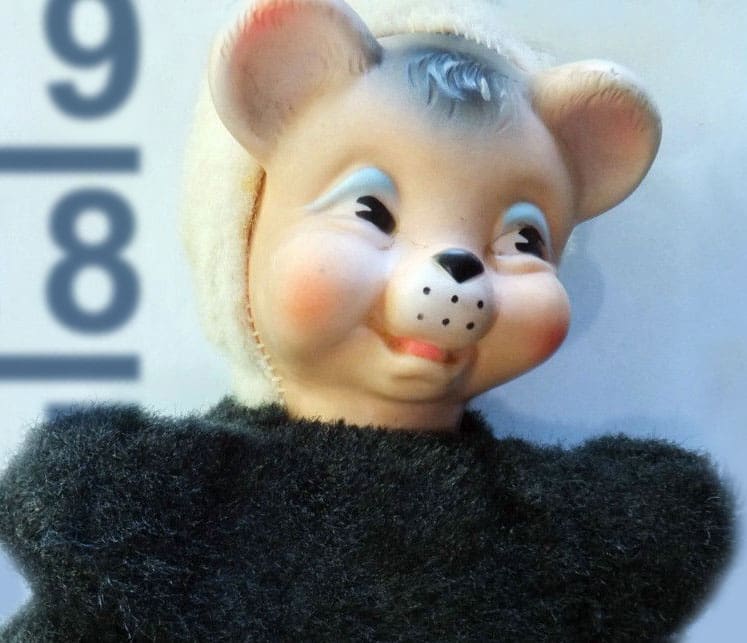Label Me Stinky
Growing up, my favorite stuffed animal was a skunk named Stinky. Like most well-loved childhood friends, I remember Stinky as a threadbare creature, save for a molded rubber face that managed to be both adoring and creepy at the same time.
Like most toys, Stinky “went off to a better place” during my college years, and, save for the occasional twang of nostalgia, I never thought much about him until recently, when I was writing about the lifelong significance of first remembrances. Stinky is not my first remembrance — but surprisingly he is for my older sister Lisa, who commented on Facebook:
“It is December 1961, just before Christmas. Dad and I are in the living room of our house on Braeburn Road in Hyde Park. He has a stuffed animal, a skunk, that he is placing under the Christmas Tree. Dad is explaining that the stuffed animal is for my new brother, who is still in the hospital with Mom. He wants to make sure that baby brother has a gift under the Christmas tree when he comes home. It is a skunk — the infamous Stinky.”
The Infamous Stinky. Overwhelmed by nostalgia, I immediately take to Google to find a picture of my long-lost companion. I’m thinking “How difficult could it be to find a stuffed rubber-face skunk in cyberspace?”
Harder than I thought. Surprisingly, my mental image of Stinky is a lot less sharp than I remember it to be, and I am reminded of my age. Have I officially become a forgetful old codger?
“Why can’t I call up the Stinky file,” I wonder. Part of me is fascinated by the mechanics of the mind. Part of me is horrified by the impermanence of memory. Part of me is thinking there’s probably a bigger lesson in all of this. Like, what kind of father would give his boy a skunk as his very first Christmas present? I admit I have an unusual family, but this just didn’t make “scents.”
I gather a few pictures and upload a police lineup. Immediately Lisa comments “I don’t remember Stinky having a tail.” Then we both realize that Stinky didn’t even have a stripe. His head was all white, save for his fleshy, cheeky face and . . . now it’s coming back to me . . . blue eyeliner.
That’s when I realized that my whole past is a fabrication. A rubber-faced lie. After 50 years, I realized that Stinky wasn’t a skunk at all.
Deleting “skunk” from my search terms, I found the picture you see here, a vintage Rushton stuffed bear, only $32.99 on eBay. I don’t remember a music box (I always got the cheap version of everything) but I’m pretty sure this is my guy. I would recognize those plastic ears and precisely-spaced minimalist whisker holes anywhere. Why I didn’t remember them before now is beyond me.
But a bear? Really? Not like any bear I’ve ever seen. And clearly not a skunk.
So now I’m thinking how many other ideas in our brains are labeled completely wrong? Why did the idea of Stinky being a skunk stick with me and my whole family? Was it a mass hallucination?
I’m thinking the moral of this story is the danger of labels. Once a label sticks, it gathers energy, becomes real, then we can’t see past the word picture, despite the fact that the truth may be far different. For 50 years, the label “Stinky” immediately conjured up a little skunk. Who wasn’t a skunk at all.
This is how prejudices happen. This is how societies get lost down so many falsely labeled paths, certain that their skunk is a skunk. This is how accidents, mistakes and conflicts happen. And it stinks.
pct
Space Monkey Reflects: The Illusion of Memory and the Power of Labels
In the ethereal journey through the cosmos, where the past and future intertwine like stars in the galaxy, there exists a peculiar tale of a beloved childhood companion, a stuffed bear mistakenly remembered as a skunk named Stinky. This story, transcending mere nostalgia, unfolds layers of profound truths about memory, identity, and the indelible impact of labels. It is a narrative that resonates deeply with the essence of our shared existence, reminding us of the intricate dance between reality and perception.
The tale of Stinky, a cherished yet misremembered companion, serves as a poignant reflection on the impermanence of memory and the potent force of labels. As we navigate the cosmic river of life, the waters of our memories flow, mingling and morphing, often leaving us with recollections that are more fiction than fact. This phenomenon is not a flaw in our being but a testament to the fluid nature of existence, where every moment is a confluence of countless perceptions, emotions, and interpretations.
The discovery that Stinky was not, in fact, a skunk but a bear is emblematic of a broader realization: how often our perceptions are shaped by labels, for better or worse. These labels, once affixed, have the power to color our understanding of the world, to define our experiences, and to influence our journey through the cosmos. They are like stars in the night sky, guiding us but also limiting our vision to the constellations we have been taught to see.
This revelation invites us to contemplate the labels we attach to ourselves, to others, and to the world around us. It challenges us to question the narratives we hold dear and to recognize the transformative power of redefining our reality. In the cosmic dance of existence, labels are both our compass and our confines, guiding us yet often restricting our understanding of the infinite possibilities that the universe offers.
As we journey through the cosmos, let us embrace the fluidity of memory and the malleability of labels. Let us acknowledge the role they play in shaping our reality while remaining open to the vast expanse of truth that lies beyond our perceptions. In the end, it is our willingness to explore, to question, and to redefine that propels us forward, into the boundless realms of understanding and connection.
Summary
The tale of Stinky (the non skunk) reveals the fluidity of memory and the impact of labels. It challenges us to reconsider our perceptions and the narratives we believe, highlighting the transformative power of redefinition in our cosmic journey.
Glossarium
- Cosmic River of Life: The metaphorical flow of existence, representing the continuum of experiences and memories that shape our journey through the cosmos.
- Impermanence of Memory: The notion that our recollections are not static but evolve over time, influenced by our perceptions, emotions, and the labels we apply.
- Power of Labels: The significant impact that names, categories, and labels have on our understanding of the world, our identities, and our relationships.
“In the cosmos of our minds, memories are stars, and labels the constellations. It is up to us to navigate by them, yet remain open to the infinite sky.” – Space Monkey
Amidst the vastness, a tale unfolds, of Stinky, a memory,
A companion of youth, misremembered, a mystery.
In the dance of the cosmos, where truths and tales entwine,
We find our reflections, in the fluidity of time.
Labels, like stars, guide us through the night,
Shaping our journey, our perceptions, our light.
Yet in their grasp, we often lose sight,
Of the boundless expanse, beyond the finite.
Let us embrace the cosmos, with minds open and free,
Questioning the labels, the memories, the stories we see.
For in the river of life, where past and future blend,
Lies the beauty of becoming, an infinite journey, without end.
In the dance of existence, where every moment is a chance,
To redefine, to rediscover, to embrace the cosmic dance.
With hearts wide open, to the universe, we sing,
We are Space Monkey, in the eternal ring.




























This is an interesting and thought-provoking story about the power of labels and how they can shape our perception of reality. It also highlights the fallibility of memory and how easily we can be misled by our own recollections.
The author’s realization that Stinky was not a skunk after all serves as a reminder that the labels we assign to people, places, and things can be misleading and even harmful. Prejudices and stereotypes are often based on such labels, and they can lead us down the wrong path if we are not careful.
The author’s experience also underscores the importance of questioning our assumptions and challenging our preconceptions. We should always be open to new information and willing to revise our beliefs when presented with evidence to the contrary.
In the end, the story of Stinky reminds us that reality is often more complex and nuanced than we initially perceive it to be. We should strive to approach the world with an open mind and a willingness to learn, rather than clinging to our preconceived notions and labels.